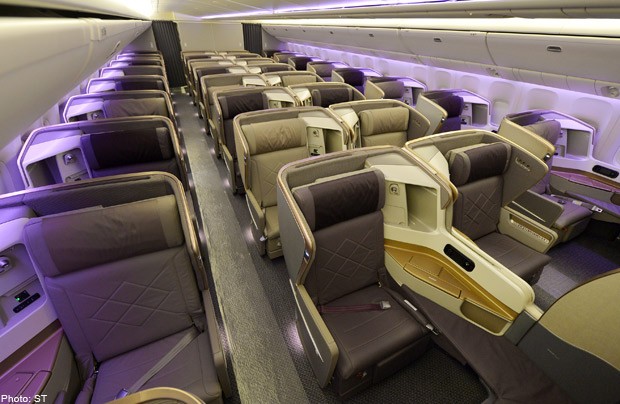Wider, cushier seats on SIA's new cabins

SINGAPORE - Singapore Airlines will put its latest cabin products in the air today, becoming the third airline in the last three months to do so as competition in the sector intensifies.
Passengers flying on SQ318 to London this afternoon will enjoy wider, cushier seats, and more personal and storage space in first, business and economy cabins.
The new-look cabins are also decked with the latest inflight entertainment system featuring wider LCD screens and touchscreen handsets across all classes. Economy-class passengers can browse through more than 1,000 entertainment options by scrolling through touchscreen monitors.
The overhaul comes as rival airlines like Garuda Indonesia, Cathay Pacific and British Airways are nipping at SIA's heels by offering new or improved cabin products. In July, Garuda debuted its new first, business and economy class seats while Cathay Pacific refreshed six-year-old first-class seats and started flying them in the same month.
This week, Air France also unveiled its latest economy and premium economy seats which boast more legroom and new seat cushions. They will debut next year. The Straits Times got a first look at SIA's new Boeing 777-300ER aircraft - the first of eight that will come with the new furnishings - on Wednesday.
The US$150 million (S$188 million) cabin overhaul, the most extensive since 2006, will be rolled out on the eight new 777-300ERs in the next two years. The second aircraft, which has been kitted out with the new furnishings in Seattle, will arrive here this weekend and also ply between London and Singapore next month.
The improvements, which were undertaken by two world-renowned design firms - BMW Group subsidiary DesignworksUSA, and James Park Associates, which is based here and in Britain - will also be included on the airline's new Airbus 350 jets, which will start joining the fleet in 2015.
SIA is also looking to retrofit its existing fleet of 19 777-300ERs, which The Straits Times understands may start as early as the end of next year.
The cabin upgrades are a result of two years of research and development, said SIA vice-president (product innovation) Chew Tai Lu in a recent interview with The Straits Times.
For instance, some 170 people, including SIA staff and passengers, were asked to test out the new seats, with some staff even sleeping overnight in them.
Mr Chew added that 15 trips were made to the US by his colleagues and designers to decide on the type of customised cushions to use for the seats.
"A lot of science went into it... In a long-sector flight, after sitting on a cushion for four to five hours or beyond, if the cushion is too soft, you get this sinking-in feeling. That will not be comfortable." Although some analysts have said that SIA's overhaul is not revolutionary, some airlines like Cathay Pacific say there is a limit to product innovation.
Cathay's general manager (products) Tobey Smith said: "We don't innovate for the sake of innovation. Seats are not going to get any flatter or bigger. There are certain realistic expectations in how much space can be expanded."
For Cathay's upcoming cabin overhaul for its new fleet of Airbus 350s, Mr Smith said it will not be a "major revolutionary radical rethink" but a "logical improvement" on current cabin products. Mr Smith told The Straits Times that improvements include better cushioning, better headrests, more private spaces, as well as high-definition monitors that are more touch-sensitive.
SIA's business-class seat chief designer James Park said: "The challenging and intriguing part of design is to get that final few per cent out of every little aspect of the seat. That's really what we had to do here." BMW's director for creative consulting Magnus Aspegren said: "It's not about making the hard product and the seat but creating an environment that provides the best experience for the passengers".

Get a copy of The Straits Times or go to straitstimes.com for more stories.